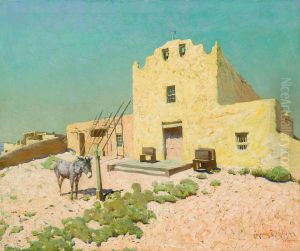Frederick Melville Du Mond Paintings
Fredrick Melville Du Mond, often spelled as Frederick Melville Dumond, was an American landscape painter known for his work on the American West and his association with the California art community. Born on November 20, 1865, in Rochester, New York, Du Mond studied at the Art Students League in New York under influential artists such as George de Forest Brush and H. Siddons Mowbray, which helped him develop his skills and style.
In the early stages of his career, Du Mond worked as an illustrator, contributing to publications such as Harper's Weekly. He later moved to California, where he became a significant figure in the early California art scene. There, he taught at the Throop Polytechnic Institute, now known as the California Institute of Technology, and he also joined the faculty of the Art Students League of Los Angeles, where he influenced a new generation of artists.
Du Mond's landscapes are characterized by their attention to light and atmosphere, which he captured through plein air painting—a practice of painting outdoors to achieve direct observation of the natural world. His works often depict the grandeur and expansiveness of the American West, including the deserts of the Southwest and the monumental Yosemite Valley.
He exhibited his works at various institutions, including the Paris Salon, the Pennsylvania Academy of the Fine Arts, and the St. Louis Exposition, among others. Du Mond was also a member of the California Art Club and the Salmagundi Club, which were crucial to his networking and status as an artist.
Fredrick Melville Du Mond passed away on February 4, 1951, in Sierra Madre, California. His legacy lives on through his contributions to American landscape painting and his impact on the California art community. His works are held in several collections and continue to be admired for their portrayal of the American West's natural beauty.
